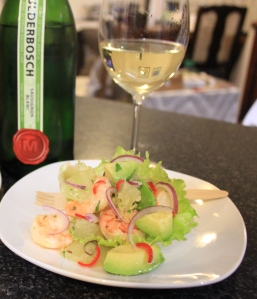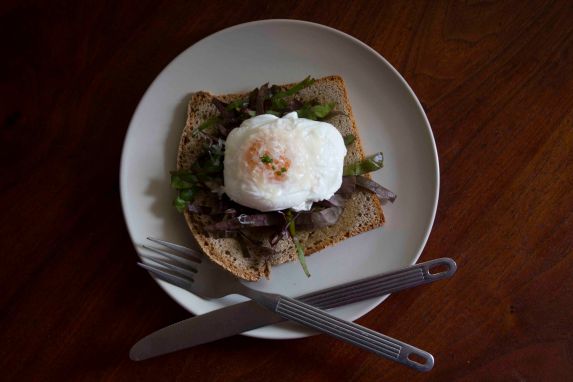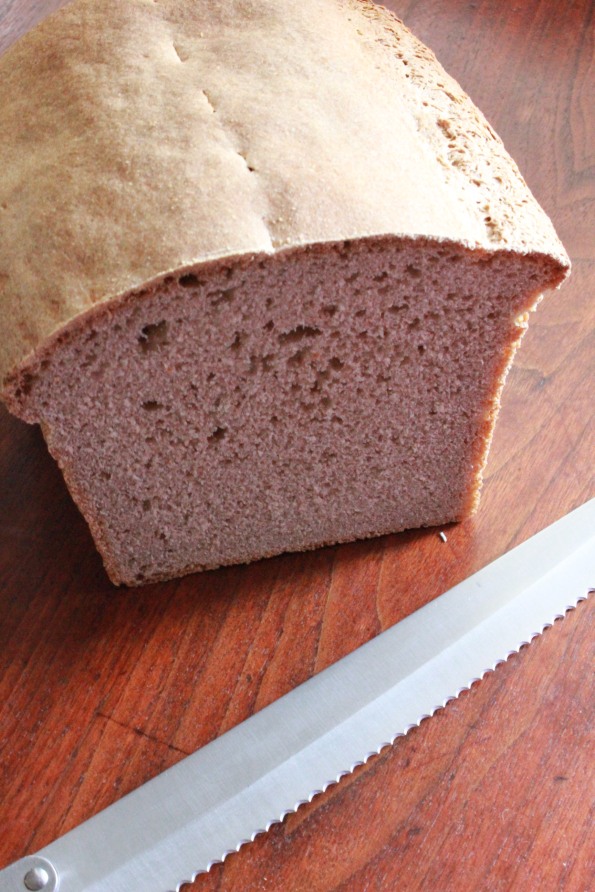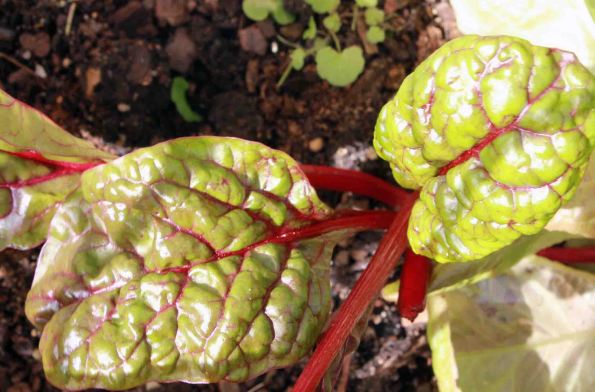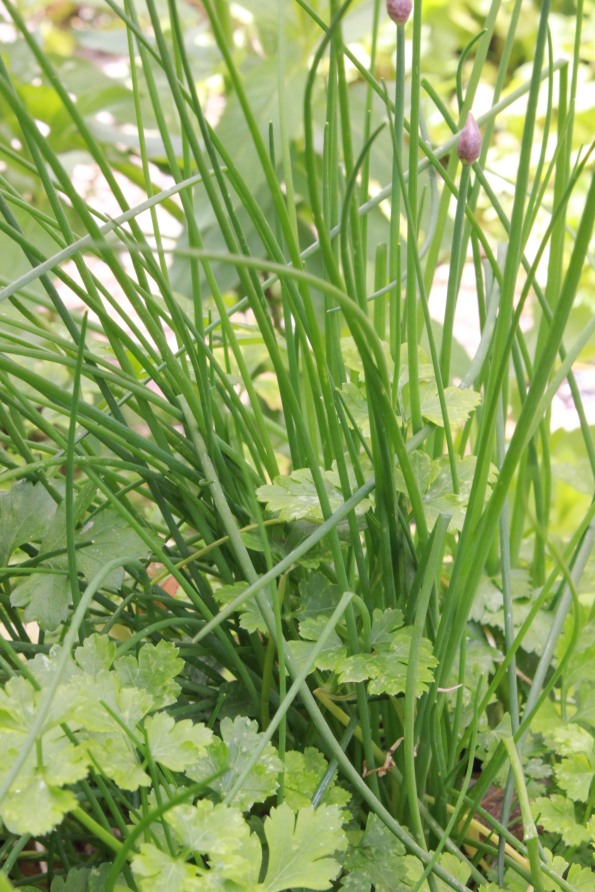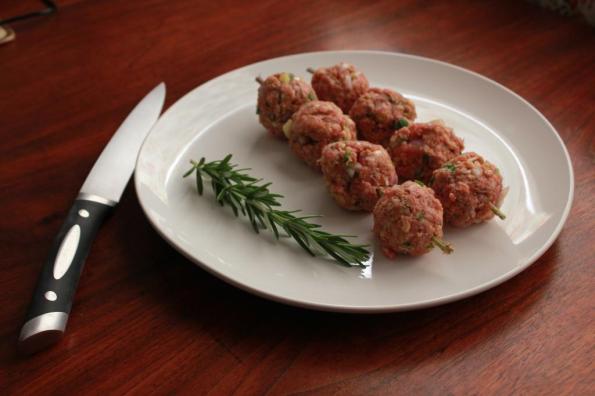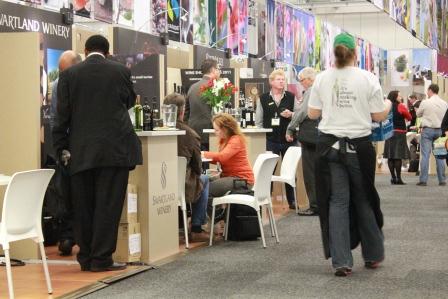Some thoughts on Sauvignon Blanc

 We dined last night at one of my current favourite restaurants, De Brasserie on Beach Road, Strand. The evening commenced on the terrace, in the cooling evening air, overlooking False Bay and the setting sun.
We dined last night at one of my current favourite restaurants, De Brasserie on Beach Road, Strand. The evening commenced on the terrace, in the cooling evening air, overlooking False Bay and the setting sun.
No such experience would be complete without a glass of wine from which to sip, so after perusing the wine list, I settled on a bottle of Almenkerk 2013 Lace Sauvignon Blanc, suitably chilled. I’d have been more inclined to go for a Chenin Blanc, but I deferred to the company: dear wife Eppie, Bolander editor and friend Carolyn Frost, and fellow journo and friend Andrea Powell, all have a preference for Sauvignon Blanc. I’ve made no secret of the fact that I am less than enamoured of Sauvignon Blanc, although in the last two to three years, the rapier-like acidity and one dimensional fruit profile – green – of so many of these wines has shifted remarkably, so I was intrigued to see what the Almenkerk Lace had to offer.
We’re more and more seeing Sauvignon Blanc of elegance and finesse, with complex, pure fruit that renders green, white and even mildly tropical notes. Shift in response to consumer demand? I’d like to think so, but be that as it may, I’m drinking Sauvignon Blanc far more willingly now than I’ve done in the past, and my experience last night – because The Almenkerk Lace is one of these far more elegant, complex and fruit pure wines – has brought me to the point where I might actually admit to liking Sauvignon Blanc as a varietal. It’s cool climate origins are evident in it’s mineral core, steely dryness, and lingering intensity, and it is a fine example of what is being crafted in the Elgin Valley.
After a splendid meal – I had my regulation sirloin steak, Eppie had the Norwegian Salmon special, Carolyn the chicken Satay skewers with a peanut sauce, and Andrea had the Thai beef salad – served by a warm, attentive staff, we lingered for a short while before splitting up and heading home.
Since it was an early dinner engagement, we arrived home just before nine o’clock, and I had the urge to drink another glass or two of wine. I’ve had a bottle of the Shannon Vineyards 2104 Sanctuary Peak Sauvignon Blanc in the fridge for the last few days, and was planning to open it quite soon, but the temptation to compare what I’d just drunk with this wine from the same valley, was overwhelming. And what a good decision it was.
What struck me immediately was just how pale the Sanctuary Peak Sauvignon Blanc is, paler even than the Almenkerk Lace. The next kicker was the remarkable nose, redolent of lemon, lime and sherbet aromas, with a hint of minerality in the form of a whiff of flintiness.
The palate has a seamless mineral core, supported by steely dryness, and an intensity of complex fruit that ranges from elegant green, through white stone fruit to a delicate tropical edge. The fruit it bright and slightly sweet, but it is beautifully balanced by the steely dry acidity, and the finish just goes on forever.
The two wines are similar, but also different. Similar in that their origins are obvious, reflected in the commonality of elegance, underpinned by a mineral core, complexity of fruit, and lingering intensity, and that is unsurprising since they’re grown on the opposite slopes of the Palmiet River Valley which wends its way through the Elgin Valley, on its way to the sea at Kleinmond.
But they differ in palate depth and breadth, the Almenkerk Lace lighter in palate weight, and more tropical in fruit expression, the Shannon Sanctuary Peak weightier in the palate with great intensity and white stone fruit and lemony sherbet fruit sweetness. I think I’m hooked. On both of them.
Avocado Ice Cream with Strawberry Fans, Balsamic Glaze and Black Pepper
| Preparation Time: 45 minutes | Cooking Time: 0 minutes | Yield: Lots! |
 Avocado pears have always had a special place in my culinary heart, because my late mum loved them with an abiding passion. When we lived in Durban, they were of course freely available, as they grow there virtually like a weed. A short distance from our home in Westville, which was perched on the edge of a wooded valley, was a grove of avocado pear trees that were originally planted by an Indian farmer who was moved off his land during the apartheid years when the Group Areas Act was enforced. Although his farming dreams were shattered, his avocado pear trees prospered, and perhaps still stand in silent tribute to his efforts of all those years ago. Whenever Mum wanted some avocado pears, I was dispatched to go on a picking expedition. Upon my return, with the treasure trove of plump, ripe avos, she would slice one in half, remove the pip, and eat it straight out of the skin, seasoned with salt and pepper and a sprinkling of balsamic vinegar.
Avocado pears have always had a special place in my culinary heart, because my late mum loved them with an abiding passion. When we lived in Durban, they were of course freely available, as they grow there virtually like a weed. A short distance from our home in Westville, which was perched on the edge of a wooded valley, was a grove of avocado pear trees that were originally planted by an Indian farmer who was moved off his land during the apartheid years when the Group Areas Act was enforced. Although his farming dreams were shattered, his avocado pear trees prospered, and perhaps still stand in silent tribute to his efforts of all those years ago. Whenever Mum wanted some avocado pears, I was dispatched to go on a picking expedition. Upon my return, with the treasure trove of plump, ripe avos, she would slice one in half, remove the pip, and eat it straight out of the skin, seasoned with salt and pepper and a sprinkling of balsamic vinegar.
An invitation to create recipes for the Afrikado Blogger Challenge, an initiative by major avocado producer ZZ2 to encourage innovation in the use of avocados in the kitchen, prodded me into coming up with something really different. I’d done the usual before: guacamole, salads and even cold avocado soup (another of Mum’s favourites), so I decided to make ice cream for the first time.
I have no ice cream machine, and quite frankly, it’s not necessary if you devote a little time and elbow grease to the undertaking. The main thing to do, is to break down the ice crystals that form when you freeze the ice cream, and you do that by whipping it briskly and fairly frequently as it sets.
It is neither sweet nor savoury: it just tastes of avocado pear, which the salt and pepper help to emphasise, so it lends itself to a variety of uses. I’ve made a dessert this time around, but it could easily be plated with a savoury item to make a starter.
Ingredients, selection and preparation
5 ripe medium sized fully ripe avocado pears
250 ml double cream: you can use ordinary cream, but it lacks texture somewhat
5 tbsp honey
4 tbsp lemon juice
1 ml black pepper: very finely ground
2 ml salt
250g fresh strawberries
Balsamic glaze: you can make your own, but it is easier to buy it.
Freshly ground black pepper
Method
Boil a kettle of water, and pour over the avocado pears in a large bowl, leaving to stand for a minute. Drain and plunge into cold water. This will ensure that the avo flesh does not discolour for up to six hours, a tip I gleaned from Erica Platter’s cookbook, “East Coast Tables” while doing my research.
Halve and scoop out all the avodaco flesh. Remove any discoloured spots, and place in a, large freezer proof mixing bowl. Mash until completely smooth.
Add the honey, cream, lemon juice, pepper and salt.
Whip briskly until homogenised and completely smooth.
Cover the surface of the mixture with a sheet of cling film, and place in v the deep freeze until it starts to set, about 30 to 45 minutes. Remove from the freezer and whip briskly to break up the ice crystals. Cover and return to the deep freeze.
Repeat this process every half hour or so, until it thickness to the point where it is set.
Remove from the deep freeze and allow it to soften slightly before serving.
Serve two scoops of ice cream with a trio of strawberry fans garnished with balsamic glaze, and sprinkling of freshly ground black pepper. Enjoy!
Avocado, prawn and shaddock salad
| Preparation Time: 20 minutes | Cooking Time: 10 minutes | Yield: 4 |
You’re probably wondering what a shaddock is, and well you might. A visit to Danie Truter’s farm Daniels Hoogte on top of Aurora Mountain a few weeks back, introduced me to this interesting fruit. Known by some as pamplemousse (French for grapefruit), it is an enormous citrus fruit with a really thick pith.
It tastes something like a cross between an orange, a lemon and a grapefruit, and is much lie a white grapefruit in colour. We brought one home with us (you may well have seen it in last week’s recipe photo, behind the wine glass), and pondered how to put it to good use.
It came up for discussion at a night out at the Lanzerac Hotel two weekends back, with Giggling Gourmet Jenny Morris, who suggested some sort of a salad with prawns, and eventually Mrs M and I ended up with this delightful starter salad, and although it is winter, the current balmy weather makes it quite acceptable.
If you can’t get hold of a shaddock, a large grapefruit, either white or ruby will do just as well.
But it is the avocado pear that really finishes the salad off beautifully, with its velvety texture, and unctuous voluptuousness.
The wine match was also a no-brainer. A visit to the stylish Mulderbosch Tasting Room for a lunch of pizza (excellent thin crust, lovely toppings, well worth a visit if you’ve not been there) and their delightful Rosè, resulted in us laying in a small stock of wine, one of which is the lovely tropical style Suvignon Blanc.
Ingredients, selection and preparation
1 avocado pear: peeled and cubed, but at the very last minute to prevent it from going brown.
1 cup (250 ml) shaddock segments: cut the segments out of the fruit with a sharp paring knife, excluding the skin that surrounds the segments.
200g prawns: deveined, shelled and beheaded.
Canola oil: for frying.
1 red chilli: deseeded and finely sliced.
½ small red onion: peeled and finely sliced.
A few mints leaves: very finely sliced.
½ tsp cumin seeds: toasted in a dry pan until the aromas are released.
4 lettuce leaves: ideally from a medium sized lettuce, which will give you a nice cup shape to contain each salad portion.
(Dressing)
1/3 cup (85ml) shaddock juice: squeezed from what you have left over, after you’ve cut out the shaddock segments.
1 clove garlic: crushed.
½ tsp sugar
½ tsp of fish sauce
½ tsp sesame oil
Method
Heat a small wok until it begins to smoke. Add a tbsp. or two of canola oil, swill it around the wok, and flash fry the prawns until they colour and become opaque, in small batches. Set aside to cool.
Combine the salad ingredients and divide between the four salad leaf cups. Combine the dressing ingredients in a small bottle and shake well to emulsify, until the sugar has dissolved.
Anoint the salad portions with the dressing, and garnish with the sliced mint.
Wine match
The 2012 Mulderbosch Sauvignon Blanc worked particularly well with this salad. A lovely pale straw, shot through with a green tinge, it is fresh and tropical on the nose, with citrus lime whiffs.
The palate is all about taught mouth-watering acidity, bright fresh fruit flavours, a mineral edge and persistence. A great drop.
Avocado soup
| Preparation Time: 60 minutes | Cooking Time: 15 minutes | Yield: 4-6 |
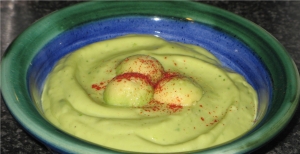 Wedding anniversaries being what they are in our household, the choice is often eat out, but considering the current state of the world’s financial systems, prudence dictated eat in last week, when our 32nd wedding anniversary rolled around, which was significant enough to warrant a three course dinner complete with bubbly.
Wedding anniversaries being what they are in our household, the choice is often eat out, but considering the current state of the world’s financial systems, prudence dictated eat in last week, when our 32nd wedding anniversary rolled around, which was significant enough to warrant a three course dinner complete with bubbly.
The main course was crispy roast duck with watercress mash and warm beetroot salad, and the dessert was a devastating crème caramel.
After much thought, and considering the Afrikado Challenge, I realised that something which my dear old late mum used to make, would be ideal: cold avocado soup.
I have so many wonderful memoriess of the elegant dinner parties my mum used to host when the family lived in Durban. Anything from three to five courses, and anything from four to twelve guests, every single course prepared with meticulous attention to detail by mum, and a table setting that would have put the Royal Hotel to shame, complete with silver plate. One of the many dishes I remember enjoying was her cold avocado soup, and considering that summer has arrived, this is what we settled on.
According to mum, the original recipe comes from one of Lynn Bedford-Hall’s books, but I had to make a couple of changes, because the first version didn’t quite work out right.
Ingredient Selection and Preparation
2 medium or 3 small avocado pears: they must be blemish free and ripe. Leave them until the very last, because if you peel them too early, the pulp will start to oxidise. When you do peel them, check very carefully for any brown spots, and excise them carefully. Mash well with a metal fork.
3tsp lemon juice
25ml chopped parsley
2 spring onions: finely chopped.
30g butter
40g flour
400ml chicken stock: if you use stock powder, be sure to strain the stock before you use it.
400ml milk: heat it to just below boiling before you use it.
Salt and pepper to taste
Paprika to garnish
Avocado balls to garnish: I gouged them out of another avocado pear, using a melon scoop.
Method
Make your chicken stock and heat the milk.
Melt the butter in a medium saucepan and add the flour bit by bit, stirring in with a balloon whisk until all the flour is integrated into the butter.
Remove from the heat, and add the chicken stock followed by the milk, stirring all the time with a balloon whisk. Be sure that there are no lumps.
Return to the heat, and cook for about three minutes or until the sauce is smooth and thickened nicely. Stir constantly to prevent sticking.
Season the sauce to taste with salt and pepper.
Remove from the heat, and pour into a glass mixing jug large enough to accommodate the white sauce as well the avocado pulp. Place a sheet of cling wrap on top of, actually touching the surface of the white sauce, to prevent a skin from forming while it cools.
Set aside to cool to room temperature. This is very important, because if you add the avocado pear pulp to white hot sauce, it will oxidise and turn brown. I know this because this is precisely what happened with the first batch I made!
Once the white sauce has cooled completely, blanch the avocado pears in boiling water for a minute, then peel and mash them. Add to the white sauce, together with the 3tsp of lemon juice, the parsley and spring onion.
Puree the mixture in a blender jug, or with a stab blender.
Divide between four or six bowls, and garnish each with three or four avocado balls and a sprinkling of paprika.
Enjoy!
Garden Route Shiraz 2011: Easy drinking, somewhat enigmatic…
“Location: Calitzdorp • Map: Klein Karoo & Garden Route • WO: Durbanville/Outeniqua • Est/1stB 2008” reads the entry in Platter’s 2012 for Garden Route wines.
The bottle in my hand reads “Garden Route Shiraz 2011, Wine of origin Outeniqua” on the front label. The Platter entry lists the 2007 Shiraz, made from Durbanville grapes, noting that the 2011 Shiraz is made from grapes grown in the Outeniqua wine ward, one of the newer wine wards to emerge in the Southern Cape in the last few years. It’s all thoroughly confusing really. What happened to the ’08, ’09 and ’10 vintages I wonder. Where did the grapes come from ? Or did they just not get made?
The wines (I received the 2011 Shiraz and 2012 Sauvigon Blanc via courier a couple of weeks ago) are made at De Krans in Calitzdorp, by the redoubtable Boets Nel, he of De Krans Port fame. Aside from a slew of competition honours, half the De Krans page entry in Platter’s is a solid block of red type, indicating 4 1/2 and 5 star wines, testimony to the winemaking prowess of Boets, and not just in the port and dessert wine stakes. The 2010 Touriga Nacional and the 2006 Redstone Reserve, a blend of Touriga and Cab Sauv, both crack 4 Platter stars.
So it’s entirely reasonable to expect that he should be able to put together a credible Shiraz, which if you taste the 2011, you may well agree he has done. Okay, I don’t believe it’s a 5 star wine, but it is entirely drinkable, inky garnet in colour, with a dense black fruit nose of plums and blackberries on vanilla and earthy spice notes.
The palate speaks of surprisingly dense black fruit, with cracked black pepper notes, underpinned by gentle oak and a vanilla edge. The fruit is mouthfilling, juicy and is balanced by pleasing acidity, the tannins very soft and gentle for a 2011 wine. Ten months in 2nd and 3rd fill French barrels make for well integrated oak. I don’t believe it’ll last for ever, but I doubt it’s meant to. It’s a typical cool climate wine, with bright juicy fruit, made to drink young.
I drank it with a very mild chicken curry, not the ideal pairing I admit, but it was passable good nonetheless. It’ll do well with a traditional roast, beef or lamb, and it’ll also do great with a slab of steak, or with a typical South African braai.
Drinking well now, it retails at R92 a bottle. The 2007 gets 3 1/2 Platter stars, and the 2011 cracked best Shiraz at the Klein Karoo Young Wine Show that year.
Stanford University Organic Study: Is organic REALLY no healthier?
It sure is lovely to be right, isn’t it? Three Michelin star British chef Marco Pierre-White, makes smug look humble in his recent gloating rant over the findings of Stanford University in a comprehensive study of the nutritional value of organic versus conventionally grown produce. The study, a meta-analysis of some 200 research papers, found that there is no nutritional benefit in consuming organic produce instead of conventionally farmed produce.

Organically grown spinach. It may have the odd blemish, but it’s a damn side healthier in my view than the “conventionally” grown stuff.
Since the publication of the study however, it has been criticised in a number of areas. Susan Clark, executive director of the Columbia Foundation, a non-profit organisation dedicated to the furtherance of public welfare across a broad front, was quoted in an article on The New York Times web site: “The researchers started with a narrow set of assumptions and arrived at entirely predictable conclusions. Stanford should be ashamed of the lack of expertise about food and farming among the researchers, a low level of academic rigor in the study, its biased conclusions, and lack of transparency about the industry ties of the major researchers on the study. Normally we busy people would simply ignore another useless academic study, but this study was so aggressively spun by the PR masters that it requires a response.”
It turns out as she notes, that more than one of the researchers had interesting links to Big Tobacco, having both worked for the powerful Tobacco Institute which sought to “prove” that tobacco consumption posed no health risks.
The aforesaid notwithstanding organic (and biodynamic for that matter) foodstuffs are more expensive. If the Stanford study was in fact accurate this would mean that everybody, not just the less well-heeled in our skewed society, could safely disregard organic produce in future.
But you would be wrong in that notion, because nutritional value aside, it is arguably healthier because of the lack of pesticides, herbicides, and organo-phosphate fertilisers in fruit and vegetables, and the growth hormones and antibiotics in animal products. And let’s not forget the inhumane treatment that is inherent in factory farmed animal products.
What I find most odd is the use of the term “conventional” to describe contemporary factory style farming, when in fact for the greater period of our agricultural history, organic was conventional. When man evolved from hunter-gatherer into a pastoralist and a cultivator of crops, pesticides, herbicides, and organo-phosphate fertilisers did not exist, nor for that matter did growth hormones and antibiotics.
As the world’s population grew, the need to produce more food increased apace, which is the justification for contemporary factory farming. But at what cost?
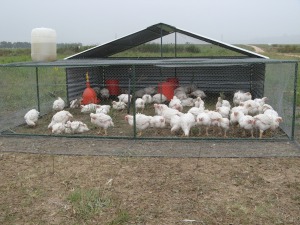
Free range chickens in their pasture pen on Spier Biodynamic Farm. Plenty of room in the cage, access to the open air, but with shelter from the elements. They get fed a small quantity of grain each day, and graze pasture if they get hungry. The cages are moved to a new patch of pasture each day. The birds are slaughtered on the farm, in a certified humane slaughtering facility.
If you take a look around you at so much of the farm land in the Boland, you’ll see how it is farmed. Fumigated soil, plastic sheeting covering the land, cultivation tunnels, frequent spraying of pesticides and herbicides are rampant. This is now considered “conventional” farming.
So much meat is raised in feedlots these days, in order to cope with demand. The idea behind feedlot farming is to fatten the animals as quickly as possible to prepare them for slaughter and the market. The best way to achieve this is to feed them on grain. This achieves rapid weight gain, plus it results in the much sought after marbling of the meat with fat, which makes it tastier and more tender. It also makes it more unhealthy because of the greater fat content. It is also true that feedlot farming has a much lower carbon footprint than pasture fed animals, but the probable solution to that, is to simply eat less meat. Feedlot farming is also anything but humane, subjecting animals to miserable lives that end in stressful slaughter, after an equally stressful road trip by truck to a commercial abattoir.
I don’t know of any animal feedlots in the area, but I do know of many battery chicken farms, the stench of which assails the nostrils as you drive past them, even from a distance. Animals reared in such circumstances suffer untold miseries, from birth to slaughter. Read Eric Schlosser’s Fast Food Nation, Hattie Ellis’ Planet Chicken or Jonathan Safran Foer’s Eating Animals if you doubt this assertion. But it doesn’t have to be that way.
Marco Pierre-White’s point that “conventionally” produced food is cheaper, and therefore more accessible is well taken. Depending where you shop, organic food can be significantly more expensive. But with the continued growth of the organic sector, and the emergence of initiatives like the Green Road, a Biodynamic Agricultural Association of South Africa (BDAASA) sponsored program to reduce the cost of organic produce by bringing producers closer to consumers, the price premium is set to decline.
And the movement back to organic agriculture is not limited to South Africa. At a BAASA meeting I attended last year, I listened to a South African couple who farm in the Boland recounting their experiences during a trip to India, where there is a concerted move toward biodynamic and organic agriculture, and away from what is now considered conventional.
So, for my money, even if I get less in return for it, it’s organic, free range and humanely produced. Mr Marco Pierre-White can spend his money any which way he chooses.
Poached Eggs with Spinach, Feta and Pecorino
Sunday mornings are usually a lazy start in our household, and today was no different. A pot of coffee (Koutaba from Cameroon, bought at The Coffee Roasting Co in Somerset West) and my Blackberry Playbook Tablet allowed me to read the news and dig into my Twitter stream.
Hunger pangs eventually did get the better of me, and my dearly beloved, who was playing Solitaire on her Playbook tablet, began to mutter about breakfast and/or lunch (read brunch), which finally drove both of us out of bed and downstairs to contemplate our options.
We’d been speculating about chicken mayo something (enough let over chicken from last night’s roast, plus a cup of homemade mayo) or maybe poached eggs, or I dared to speculate, both together…
Thankfully, Mrs M rousted me out of bed with the notion of poached eggs and something, which rapidly morphed into something based on what was in the refrigerator and the garden, to whit eggs, home-baked bread, Danish feta, Pecorino and baby spinach leaves, oh and a sprinkling of chives. And here it is!
The spinach leaves are those green and purplish coloured ones, and the eggs are free range. The Pecorino Romano is an inexpensive alternative to Parmigiano Reggiano which I’d like to eat exclusively, but unfortunately cannot afford.
The rye bread is my own recipe. I bake sourdough bread every week, a 60/40 rye/wheat loaf, which if refrigerated in a zip lock plastic bag, lasts the entire week. It makes a pretty good sandwich – it’s quite a dense loaf – but it makes magnificent toast if you cut it about 5mm thick. We seldom eat shop-bought bread for a couple of reasons, chief amongst which are the flavour, texture, quality and the cost. As a matter of course, I avoid 100% wheat bread as it gives me the most awful heartburn. Pure rye tends to be rather heavy, so my sourdough rye/wheat loaf is for me, the perfect compromise.
I baked it a couple of weeks ago with Sam Linsell (@DrizzleAndDip ), and she assures me she’ll be doing a post on her blog about that particular adventure in due course. My pure rye loaf recipe is here and I’ll be posting my sourdough rye/wheat loaf recipe real soon.
to make this lovely, simple dish to feed two people, you’ll need the following:
4 free range large or extra large eggs: the fresher the better, since this ensures that the egg white will retain its shape and keep the egg “together”.
4 slices toast: any bread of your choice, but the rye or rye\wheat is a tasty, healthy alternative
baby lettuce leaves: a handful well rinsed and shredded
4 sticks Danish feta: by Danish feta, I mean the soft and creamy one, that is usually cut into long sticks. I used an Arista product I bought from Pick ‘n Pay. Cut it into blocks.
4tbsp grated Pecorino cheese
2tsp chopped chives
My poached eggs are made the old fashioned way, in a pan of boiling water. I tossed the poaching pan years ago. This is not the stirred method, by the way, which leaves you with not much more than a yoke coated with cooked egg white, which is aesthetically great, but if you want to eat more of the high protein white, my method works better, even if it looks less tidy on the plate!
Toast and butter your bread.
Heat a pan of water until it comes to the boil. Turn down to a simmer, carefully crack each egg, and place gently into the water. I find using the back of a knife to make a clean crack in the eggshell helps avoid shell shards in the egg, and also avoids breaking the yoke.
Another method to use, is to crack the egg into a large spoon, and then to carefully slip the egg into the water. the idea is to keep the egg as “together” as possible.
Gently wiggle an egg lifter under each egg to make sure it has not stuck to the bottom of the pan. If you’re a Spray ‘n Cook user, you can spray the pan beforehand instead.
Meanwhile, butter the toast slices, and dress with the shredded spinach topped with the feta cheese.
The eggs should be done in about 3 to 5 minutes or so. you can aid the process, by spooning boiling water over the yolks. You want the egg white cooked through, and the yolk soft and runny.
Remove the eggs with a slotted egg lifter, and allow to drain of as much moisture as possible.
Place one egg on each slice of toast, anoint with grated Pecorino and garnish with the chopped chives.
Tuck in and enjoy!
Reluctant spicy meatballs
| Preparation Time: 15 minutes | Cooking Time: 20 minutes | Yield: 4 |
My response to Mrs M the other day that “I have DONE a meatball recipe already!” did not in the slightest deter her from her chosen course, despite my obvious reluctance to do another meatball recipe.
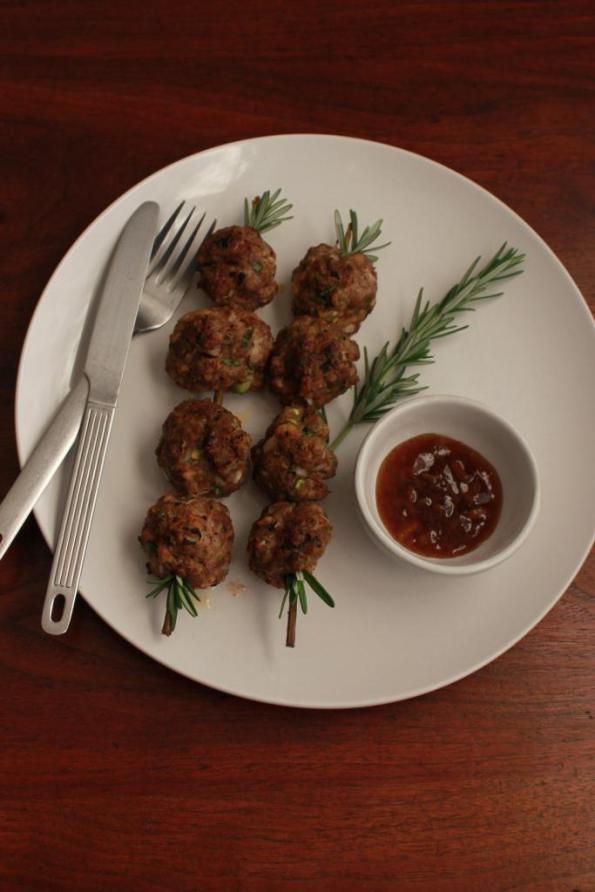
Scrumptious grilled spicy meatballs with a dipping bowl of chutney. Lovely as a snack, or as a light meal served with a crisp green salad.
She had a bee in her bonnet you see, and I’ve learned over the years not to get in the way of that bee. And a good thing I didn’t, because the meatballs that emerged are truly lovely.
I find that Mrs M is inclined to contemplate for some time before finally getting down to the business of actually making the dish and it is that contemplation that results in the final recipe coming together rather rapidly.
I’ve also noticed that if I don’t ask her to document what she’s doing, or indeed do so myself while she works, quantities and method may become a trifle hazy over time!
We have a minor rosemary forest in our diminutive front garden (there is a price to be paid for living in a lock-up-and-go security complex), and the actual genesis of this recipe was Mrs M’s desire to use rosemary stick skewers in some dish or other. If you don’t have a rosemary forest to hand, then conventional skewers will do just as well, but the rosemary skewers definitely add a lovely flavour dimension.
Cut them just a short while before you plan to use them, strip off all the leaves, and cut the top end off at an angle to make a sharpish point. Give them a good rinse to get rid of any ghoulies, then soak them in water until you use them. If you’re using ordinary skewers, you should also soak them in water for a time before using them to prevent them from burning under the grill.
And of course, there is no good reason why you couldn’t do these on the braai, and with the summer almost upon us, why the hell not? Just remember to turn them fairly regularly so they don’t burn.
Ingredients, Selection and Preparation
650g beef mince: lamb or chicken would do just as well.
3 garlic cloves: crushed
3 shallots: peeled and finely chopped
2tbsp parsley: chopped stalks and all
Bread crumbs: four slices of white bread, crusts removed, and blitzed into crumbs in a blender jug, or with a stick blender.
2tsp curry powder
1tsp chilli powder
salt and pepper to taste
2 eggs: beaten
Canola oil: to brush onto the meatballs
Method
Pre-heat the oven to 200 deg C.
Combine all the ingredients in a medium mixing bowl, and squish together until well mixed, but don’t overwork it.
Wet your hands with cold water, and form into small meatballs. Mrs M used a 30ml measure for each one.
Carefully thread four meatballs onto each of four skewers, and anoint them with canola oil.
Grill in the oven for about 15 to 20 minutes, turning halfway through the grilling time.
They make pretty decent snacks, but a skewer of four makes a nice light meal served with a crisp green salad. Either way, a small bowl of chutney for dipping rounds them of ever so nicely.
Enjoy!
Cape Wine 2012 a great success: well done WOSA
Thursday 27, 2012
Well it’s official. Cape Wine 2012 is a roaring success if the comments from exhibitors are anything to go by.
Wandering around the exhibition hall at the Cape Town International Convention Centre, I’m struck by how well organised this event has been, from the surprisingly sturdy cardboard exhibition stands, to the neatly arranged overhead banners.
The floor is abuzz with people, tasting, spitting, talking and at most every table, people are sitting in huddles, clearly talking business, and for an industry that is feeling the pinch of declining consumer spend, both locally and overseas, that is truly a God-send.
Glen Carlou’s Georgie Prout pretty much summed it up when I spoke to her this morning before the doors officially opened on the final day of the exhibition. “It’s been really well organised, from the stands themselves to the delivering of wine from store for our daily use,” she said. “it’s been slick and professional.”
Wine industry guru Ross Sleet told me that this year is even better than Cape Wine 2008, and that it provided a platform for producers to showcase their products. “It’s been great. Well organised and professionally done, and Su Birch and her team at WOSA need to be congratulated.”
Norma Ratcliffe of Warwick and Vilafonte observed that the association with food and wine was far better managed this time around. “You can’t really talk about wine without food, because they go together. This Cape Wine has really done well to emphasise that link. Every event I’ve attended that’s involved food has been so well done with the food pairings working beautifully.”
And Waterford’s Kevin Arnold was equally complimentary. “I’ve looked at the numbers, and this has been a great opportunity for exhibitors to engage with both buyers and the wine media. The WOSA team have done a great job, and deserve to be complimented.”
Jeremy Borg of Painted Wolf, was full of praise when I spoke to him on Wednesday morning. “I had a busy day yesterday, and today I have a number of appointments lined up. It’s shaping up to be a great event.”
Aside from the exhibition itself, the lectures and seminars have been very well received. I arrived at the door of the Old Vines Seminar addressed by Rosa Kruger and Prof Alain Deloire yesterday, and was unable to gain access, as it was hopelessly oversubscribed.
The Soapbox enclosure next to the vibey Swartland Independent corner, built cleverly from empty wine boxes, is also immensely popular, with a tasting or discussion happening pretty much every half hour.
So it is indeed a case of hats off to Su Birch and her team, for a well-organised and productive Cape Wine 2012.
